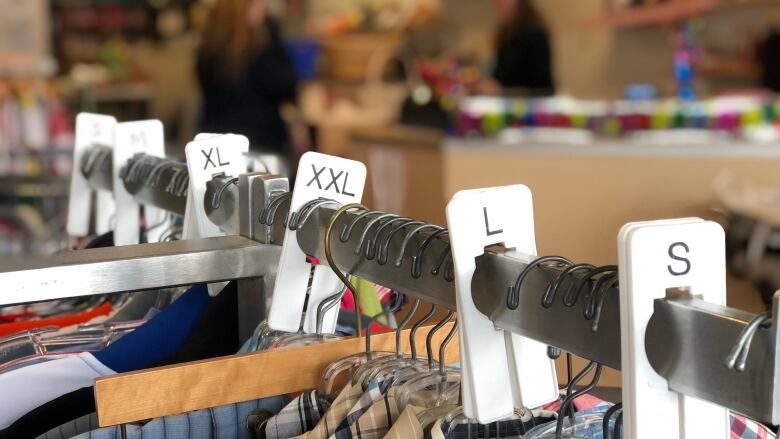How local thrift stores are staying afloat during the pandemic
Local thrift stores say purchasing used items or clothing to re-sell changed dramatically since the pandemic

When Danielle Green closed the doors to her business in March due to COVID-19 she had no idea when she would reopen, but she did know she would have to change her business model rapidly if she hoped tostay afloat.
Green owns Artisanal Design Company, a thrift store specializing in women's clothing in Kitchener.
Prior to the pandemic, Green gave cash on the spot to people looking to sell their clothing. Items she saw fit were instantly steamed and put out on the floor. With a business that relied so heavily on community involvement, closing her doors posed a huge threat.
Almost instantly she started offering curbside pickup for sellers, arranged electronic transactions and opened an online store for people who wished to shop secondhand.
"I had no background in e-commerce. I always managed my own website, but I was baptized in the fire and I had to figure it out really quick because I had a store I still had to pay for, and considering that the majority of our income was from walk-ins, I had to change it up real big, real quick in order to survive the changes,"Green said.
Paula Wilkie, owner of Carousel Clothing consignment in Kitchener, faced similar challenges when her store also closed in March.
Wilkie, who says she is passionate about offering sustainable and budget-friendly clothing, also moved online but had to put a stop to her walk-in consignment program. She decided to still offercurbside pick up, but only for people she had worked with pre-pandemic.
"If I have a consignor that I know has exceptional pieces that I know my customers are looking for, I will bring them in. I'll either pick them up curbside at their house and then I let them sit in the basement for a few days before I unpack them,"Wilkie said.

Used goods? Be extra cautious
For Green, Wilkie and Ricky Nelson, owner of uptown Waterloo vintage and consignment shop Luster and Oak, the process of purchasing used clothing items from the public to resell in their stores has changed dramatically since the pandemic, as extra caution must be taken with used goods.
All three stores have seen a similar shift as they reopened their doors to the public a few weeks ago second-hand clothes coming into the store are isolated in plastic bags or buckets for 24 to 48 hours before being steamed and put out on the floor.
"Consignment is now available and we request that everything is washed and brought in in a plastic bag and it's left overnight. I'll take a look at it the next morning. By then, I feel like with the regulations, it's ready to be sold by that point,"Nelson said.
Wilkietakes the extra step ofwashing and disinfecting incoming consignment items with quantromyicide, a spray that kills bacteria.
"[These changes mean] that we're a lot more attentive, more careful and a lot more cautious. We have the time now to do it, though, where before we were finding we were very, very busy. We're just finding people aren't coming out as much as before,"Wilkie said.
As businesses around Ontario open back up, consumers are still cautious about where they shop and what they buy. For second-hand clothing stores, this is even more complicated as the messaging about how long COVID-19 can live in fabrics has been unclear.
Thrift business growing
While the process of getting new inventory onto the floor has slowed, Green says herstore has seen tremendous growth since March. According to the analytics through her point of sale system, her sales have increased by 10,000 per cent.
She attributes some of this success to the recent push to support Black-owned businesses, but overall, she says she has had more walk-ins, more support on social media and more people becoming aware of her business.
"I had to change a lot of things in order to [see my business grow]. I had to keep it moving, even during the pandemic to make sure no one forgot about us during that time,"Green said.
Bruce Winder, Toronto-based retail analyst and author of Retail Before, During and After COVID-19 expects the thrift and consignment industry to grow rapidly as a result of COVID-19. Up to now, he says, this industry was already growing for three specific reasons.
The first is the change in income disparity. With inflation rising and wages staying roughly the same, Winder said Canadians have been working with tighter budgets and arelooking to spend less money on things like clothing.
The second reason is a change in attitude. Winder said that Gen Z doesn't have the same attitude about buying second-hand that older generations do. Thrifting and hunting for a "good find"is cool.
Lastly, Winder pointed to the growing concern of climate change. Re-using or recycling items, including clothing, is an accessible way to help the environment.
Winder suspects that in the short term, the thrift and consignment industry may experience a small hit because consumers may be afraid of buying used and risking getting sick. But in the long run, he predicts the industry will experience tremendous growth.
"More people have lost their jobs consumers are still very thrifty, they're going to be even more thrifty. They're going to have even more pressure on their budgets and also, people are going to be looking to unload items in their closets or in their house to generate cash to supplement their incomes,"Winder said.
"I have a feeling once we start to open up more and once people are more comfortable shopping again, that you're going to see further momentum with consignment and used clothing."
Optimistic about the future
Winder suspects more retail space will become available to house consignment stores. He also anticipates larger clothing stores like H&M and Zara, who are often scrutinized for selling environmentally unethical fast fashion, will begin setting aside small portions of their store for consignment.
"These companies are very smart I have a feeling, if they haven't done it already, H&M and Zara will partner with providers of used products and you're going to have some of their stores carved out. It would be silly for them to fight this. It's happening with or without them. They can either be a part of it or they can be victim of it,"Winder said.
Green also feels optimistic about the future. With so many people still collecting CERB or taking pay cuts, Green suspects that more of them will be looking to sell old items they no longer use, as will buy second-hand to save money.
By continuing to offer curbside pick up for consignors, while regularly updating her online store, she says she's catering to a wide array of customers with varying comfort levels.
"Since the pandemic, things have gotten better. We've had a lot more customers. I think that within the next six months, we will become a little bit more of a home name,"Green said.
"I think we will continue to grow in sales. I think that we will thrive. I'm really excited for the future."












_(720p).jpg)


 OFFICIAL HD MUSIC VIDEO.jpg)
.jpg)



























































































